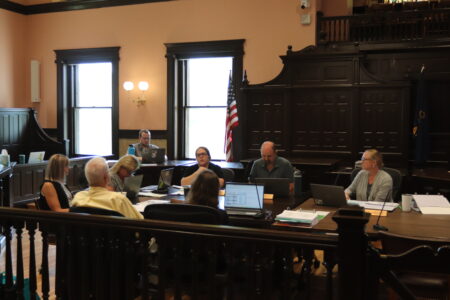Criminal justice expert says Douglas County following right script to reduce incarceration rates among mentally ill, substance abusers

photo by: Mike Yoder
Douglas County Jail
A presentation from a national advocate for mental health and criminal justice Tuesday indicated Douglas County is doing the right things to reduce the number of individuals with mental illness or substance abuse problems in the county jail.
At the invitation of the Douglas County Sheriff’s Office, Risë Haneberg, now a senior policy adviser with the Council of State Governments Justice Center and former criminal justice coordinator for Johnson County, shared with law enforcement and behavior health professionals from five counties a presentation she made last week in Washington, D.C., as part of the Stepping Up Initiative.
Founded a year ago this month by the Justice Center, the National Association of Counties and the American Psychiatric Association, the Stepping Up Initiative seeks to work with local, state and national leaders to reduce the incarceration rate of those with mental health and substance addictions.
Mike Brouwer, re-entry director of the Douglas County Corrections, said that wasn’t surprising the county was aligned with much of what Haneberg advocated during her presentation at the Law Enforcement Center. He encouraged the county to join the initiative when he saw that it was pushing for many of the things the county was doing, he said.
Douglas County is one of eight Kansas counties that have formally joined the initiative; the others are Geary, Johnson, Pottawatomie, Reno, Riley, Shawnee and Wyandotte.
Haneberg said although there has been a great deal of recognition of late for the need to address the issue, much of the focus was on prisons. Data, however, indicates more people with mental illness or substance abuse are incarcerated are in county jails, she said. The reason most often is “there is no where else for them to go,” she said.
Haneberg stressed the need to identify “criminogenic” risk factors in the two populations, and not just factors like criminal history, current charges, age of first arrest, age and gender. Noting that a vast majority of people with mental illness do not become involved with the criminal justice system, it was just as important to identify and address the risk factors as treat their mental illness, she said. Those risk factors are a history of antisocial behavior, antisocial personality patterns, antisocial cognition, antisocial attitudes, family and/or marital discord, poor school and/or work performance, few leisure or recreational outlets and substance abuse.
Throughout her presentation, Haneberg stressed the necessity for thorough documentation, the ability of different agencies and departments to share and make sense of that data and the need to track programs’ effectiveness. Effectively sharing data was problematic in the criminal justice system when law enforcement, prosecutors, courts and service providers collect different information through varied methods, she said.
Better coordination of data from different agencies is an area Douglas County officials admit needs improvement. Brouwer said Jason Matejkowski, whom the county has hired as a consultant through the Kansas University School of Social Welfare, was working to collate and aggregate the data from the different agencies for the Douglas County Criminal Justice Coordinating Council.
Although county leadership was now informed and supportive of efforts to reshape the criminal justice system, those commissioners and key county staffers eventually would leave their positions, Brouwer said. It is important to have data that supports programming and funding that improves the criminal justice system to share with those who follow, he said.
Haneberg suggested six questions should be asked when evaluating whether the county was in position to reduce incarceration numbers among the two populations. Those were:
• Is leadership committed?
• Does the system have timely screening and assessment?
• Does the county have baseline data of jail populations, length of stay, percentage receiving treatment and recidivism?
• Has the county conducted a comprehensive process analysis and service analysis and service inventory?
• Has the county prioritized policy, practice and funding?
• Does the county track progress?
Brouwer said the county could check answer “yes” to a number of those questions, including the all-important first one. For example, the county was required to provide baseline data in the grant application it successfully made last year to the Bureau of Justice Assistance. That $200,000 grant allowed Bert Nash Community Mental Health Center to hire two case managers now working in the Douglas County Jail, and they provide a positive check mark for Haneberg’s timely screening and assessment question.
Other responses Haneberg suggested would answer her questions affirmatively include a number of tasks the Douglas County Criminal Justice Coordinating Council was asked to undertake when it was formed in March. Those tasks include identifying gaps in the system, identifying costs and funding and the ongoing evaluation of programs.







